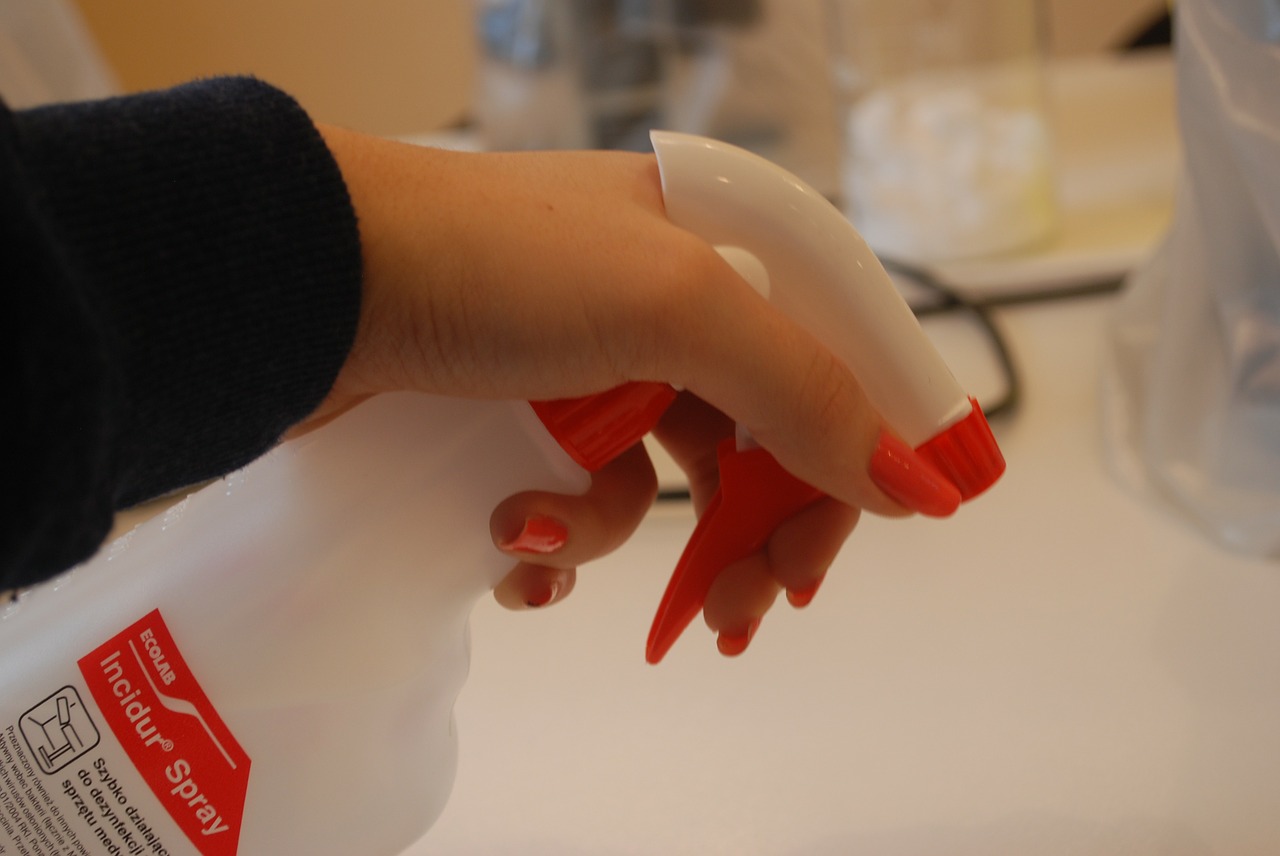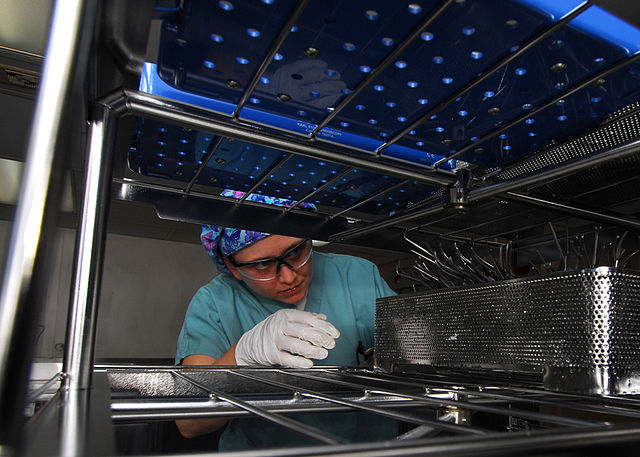Difference Between Disinfection and Sterilization
Disinfection and Sterilization are both decontamination methods. Based on the purpose of decontamination, either disinfection or sterilization can be opted.
What is Disinfection?
Disinfection is the process of elimination of pathogenic microorganisms. However, the process is not effective in case of vegetative spores. Spores may be able to survive and result in germination and hence contamination.
Disinfectants are of two major types:
1) Broad spectrum
2) Narrow spectrum
Broad spectrum is the one which can be applied to a wide variety of pathogens and narrow spectrum disinfectant is the one which is applied to a tiny variety of pathogens and are easy to use, non-toxic and comparatively less pricey.
An ideal disinfectant should:
- be able to kill microorganisms within a stipulated time period
- have a broad spectrum of performance
- should possess a longer shelf life
- be able to perform in any pH
- not be toxic or allergic
- be active in the presence of organic matter.
What is Sterilization?
Sterilization is a process of elimination. Removal. Killing, eradication or deactivation of all forms of life and biological pathogens/microorganisms like fungi, bacteria, viruses, spores, prions (infecting agents that lead to progressive neurodegenerative conditions), unicellular eukaryotic species such as Plasmodium, etc. located in some particular places, like a surface, some fluid, and medicines or in some biological culture media.
It is done by exposure to physical and chemical agents, by filtration, and in some cases by use of certain solutions. Physical methods includes heat, radiation and filtration. This is important in the veterinary and the health care industry where it is really very important to destroy highly resistant pathogens. Medical equipment’s should be thoroughly sterilized as they are used in invasive procedures with animals or humans. Bacteria, viruses and fungi are unable to stand up to sterilization.
Difference between Disinfection and Sterilization
1. Definition
Disinfection
Disinfectants are antibacterial agents that kill pathogenic microorganisms (does not include bacterial spores) which survive on inanimate (non-living) objects. A disinfectant is a chemical agent used for the process of disinfection.
Sterilization
It is a process that kills all viable microorganisms, bacterial spores and viruses. It is an absolute germ free state. Chemicals that are used as sterilizing agents are called chemisterilants.
2. Applied to medical equipment’s
Disinfection
Oximeters, ECG machines, bed-pans, gastroscopes and urinals.
Sterilization
Biopsy and surgical instruments, Cytoscopes, Foot care instruments, scalpels, artificial pacemakers, scissors, syringes and hypodermic needles and even in the manufacture of parenteral pharmaceuticals.
3. Status of cleanliness
Disinfection
Adequate cleanliness
Sterilization
Absolute or extreme cleanliness
4. Different methods
Disinfection
The different methods include physical or chemical methods. Disinfection treatment techniques include chlorination, treatment with chlorine dioxide, ozone and UV light. When in combination with traditional treatment methods, such as coagulation (the process in which liquid changes to a solid or semi-solid state), flocculation, filtration and sedimentation, positive results have been obtained.
Sterilization
The different methods of sterilization include:
- Irradiation (Gamma or E-Beam)
- Wet heat (Autoclaving)
- Ethylene Oxide gas.
- Filtration
- Flaming
- Tyndallization
- Incineration
- Steam Sterilization
- Radiation (UV, x-rays and gamma rays exposure).
- Dry Heat Sterilization (Flaming and Baking)
5. Different types of disinfectants and sterilization agents
Disinfection agents
Sodium Hypochlorite, Glutaraldehyde, Iodophor compounds, phenolic compunds, Amphoterics, Quarterary Ammonium Compounds (QAC’s or quats), Chlorox, Lysol, Peracetic acid, Chlorine dioxide, Aldehydes, Hydrogen peroxide, Ozone gas, performic acid, Potassium Peroxymonosulfate, Potassium permanganate (KMnO4), Lugol’s iodine solution, Thymol-based disinfectant, Copper Alloys, Silver, Propylene glycol and triethylene glycol, benzalkonium chloride.
Sterilizing agents
Ethylene oxide gas, Plasma gas, Chlorine dioxide, Nitrogen Dioxide, Ozone, Hydrogen Peroxide, Glutaraldehyde and formaldehyde, Peracetic acid, Radiation sterilization (electron beams, X-rays, gamma rays, or irradiation by subatomic particles), Moist heat in autoclaves, Dry-heat in ovens.
6. Processing time
Disinfection
Here processing time depends on the process which is adopted:
For e.g. heat sensitive semi critical medical patient care objects can be pasteurized for about fifty minutes.
Sterilization
Here also, the processing time depends on the process:
For e.g., heat tolerant critical equipment’s can be sterilized by use of steam (around forty minutes) and dry heat (about 1 to 6 hrs); all depends on the temperatures.
7. New methods
Disinfection
Cidex OPA (Ortho-phthalaldehyde) – FDA Cleared, Sterilox (Superoxidized water) – Not FDA/EPA cleared, Surfacine (Antimicrobial coating) – Not FDA/EPA cleared,
Sterilization
Endoclens (Liquid sterilization process) – Not FDA cleared, Rapid readout ethylene oxide biological indicator (Attest) – Not FDA cleared, New Plasms Sterilizer (Sterrad 50) – FDA cleared.
Summary of Disinfection and Sterilization
The points of difference between Disinfection and Sterilization have been summarized below: Comparion Chart
- Difference Between Global Warming and Greenhouse Effect - May 18, 2024
- Difference Between Vaccination and Immunization - March 3, 2024
- Difference Between Selective Mutism and Autism - February 25, 2024
Search DifferenceBetween.net :
1 Comment
Leave a Response
References :
[0]Omidkhoda, M., Rashed, R., Bagheri, Z., Ghazvini, K., & Shafaee, H. (2016). Comparison of three different sterilization and disinfection methods on orthodontic markers. Journal of orthodontic science, 5(1), 14.
[1]Rutala, W. A., & Weber, D. J. (2004). Disinfection and sterilization in health care facilities: what clinicians need to know? Clinical infectious diseases, 39(5), 702-709.
[2]Schneider, P. M. (2013). New technologies and trends in sterilization and disinfection. American journal of infection control, 41(5), S81-S86.
[3]Image credit: https://upload.wikimedia.org/wikipedia/commons/thumb/a/a4/Operating_Room_and_Sterilization_DVIDS286912.jpg/640px-Operating_Room_and_Sterilization_DVIDS286912.jpg
[4]Image credit: https://pixabay.com/en/laboratory-disinfection-psikanie-268551/




Good explanation